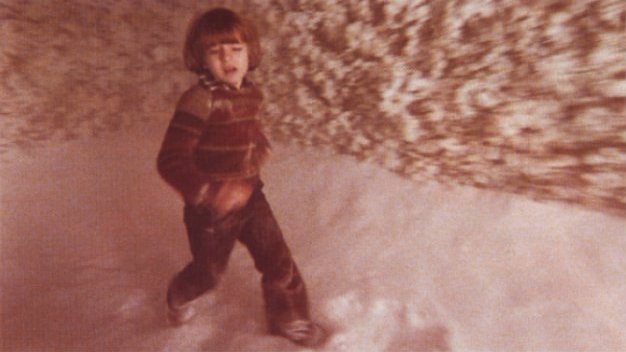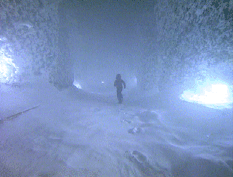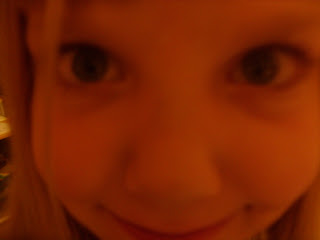 This is an image of our actress Nicole. This is the costume she is going to be wearing in our thriller. I think the image of the femme fatale we have created is very effective.
This is an image of our actress Nicole. This is the costume she is going to be wearing in our thriller. I think the image of the femme fatale we have created is very effective.
Sunday, 21 December 2008
Costume - Continued.
 This is an image of our actress Nicole. This is the costume she is going to be wearing in our thriller. I think the image of the femme fatale we have created is very effective.
This is an image of our actress Nicole. This is the costume she is going to be wearing in our thriller. I think the image of the femme fatale we have created is very effective.
Tuesday, 16 December 2008
Evaluating the mise-en-scene in The Shining.


This is the scene towards the end of 'The Shining' where Danny is escaping through the maze in order to get away from his maniac father. Stanley Kubrick utilised many generic codes and thriller conventions in this scene to create suspense and to attract the auience's attention.
Sound:
Diagetic:
Heavy panting, breathlessnessFootsteps, crunching of the untouched snow
Non-Diagetic:
Threatening background music,
Very loud, creates tension and excitement.
Lighting:
Shone from below the hedges, creates an eerie, dark, gloomy scene.
Lights up all the pure white snow, makes it look heavenly
Bright surroundings compared to the dark shape of the boy.
Location:
A maze. Creates sense of entrapment, can easily get lost, nowhere to hide, dangerous- have to be aware of every opening around you, dead-ends – cause people to get stuck and have to turn back and change direction.
A lot of snow – not ideal conditions for running/escaping in, and makes it hard to see where you are headed.
Costume:
Not ideal for being out in freezing conditions, just a jumper, trousers and shoes. No props used by the boy.
Camera Angle:
Audience can only see behind the boy, can’t see where the boy is headed. Means audience can see if anyone is following him and can see what the boy can’t see. Mid-shot. Character in the centre of the frame, running towards the camera.
Signifiers of Location:
Extreme amount of snow – scene shot somewhere cold – around winter time.
Monday, 15 December 2008
The Mass Manipulation Model
-Audiences seen as a mass of individuals that could be persuaded and influenced ("The Hidden Persuaders" book (1957) attempted to uncover some subliminal advertising techniques.)
-Media has been accused of corrupting young audiences. (1950's rock and roll, mysogynism, glorifying of guns and gangs through rap and hiphop.)
-Action from the BBFC. (This was particularly evident when the murder of James Bulger was linked to "Childs Play 3").
-Bendure and Walters. (The 'Bobo doll' experiments suggest children might imitate violent behaviour after being exposed to it. However this was criticised for not reflecting normal viewing conditions, also now children can distinguish between real and stimulated violence.)
-Drug Metaphors. (Marie Winn's book "The Plug In Drug" (1997), suggests that children watch television in a 'trance' having a 'glazed, vacous look'.
The relevance of the Mass Manipulation Model is limited in today's age of advanced media technology. Audiences are now more active rather than passive and more 'media savvy'. Audiences are aware of media manipulation and have more choice and control over how they consume media. However we should still not underestimate the power of media!
Shooting Schedule
Monday 1st December
Shoot went well, more complicated than we'd originally hoped it would be, most of the shoot tackled yet re-runs needed.
Monday 8th December
Shoot went extremely well. Majority of storyboards shot.
Monday 15th December
Unfortunately due to illness, this shoot had to be cancelled. We are hoping to book out the cameras again this week, yet if they are fully booked we will have to negotiate an extension.
Working Title Productions: Basic Information
Working Title's chairpersons are Tim Bevon and Eric Fellmer, who are listed as the most powerful figures in British Industry, and also ranked 41st in the world-wide-movie power list. Bevan had founded Working Title in 1984 with Sarah Radcliffe. However in 1992 Radcliffe left whilst Bevan was looking for a corporate backer, and Fellmer soon joined him. It has been said that, 'The films were suffering because there was no real structure, and, speaking for myself, my company was always virtually bankrupt.' This is true, as film-making as a high risk business, and is very expensive.
The 1st film that Working Title produced was My Beautiful Launderette in 1985. Working Title liked to tackle controversial topics for specific audiences, however nowadays targets a wider audience. It creates British Ideology (Four Weddings and a Funeral), and now produces bigger budget films (Briget Jone's Diary). Their films have gone from 'niche' appeal, to mainstream.
Working Title are committed to 'high quality' films, yet are also committed to low-budget films with new writers.
Push & Pull Media
These include,
-Trailers in cinemas.
-Trailers on television.
-Billboards.
-Film Reviews.
-Websites.
-Newspaper Advertisements.
-Positive word of mouth.
-Interviews with actors.
-Personal appearances by actors.
-Press Junctions.
-Tekevision Programmes.
-Adverts on social networking sites.
-Merchandising (e.g Mcdonalds).
Some of these adverts can seem as though they have been 'pushed' onto an audience, so some audiences create a sort of 'pull' in the media.
This is done by audiences
- Visiting websites.
- Choosing to watch a certain televison programme.
- Buying film magazines/reading reviews.
- Browsing in a store.
- Browsing online.
- Browsing films on film subscription sites.
Analysis of a perfume advert

Continuity Editing
A basic film editing guideline that states that two characters in the same scene should always have the same left/right relationship to eachother. If the camera passes over the imaginary axis connecting the two subject, it is called crossing the line. The new shot, from the opposite side, is known as a reverse angle.

This diagram shows the 180 degree rule.
Shot reverse shot
A film technique wherein one character is shown looking (often off-screen) at another character, and then the other character is shown looking "back" at the first character. Since the characters are shown facing in opposite directions, the viewer assumes that they are looking at each other.
Shot reverse shot is a feature of the "classical" Hollywood style of continuity editing, which deemphasizes transitions between shots such that the audience perceives one continuous action that develops linearly, chronologically, and logically.

This image shows the Shot reverse shot.
Match on Action Technique
This technique is a cut that connects two different views of the same action at the same moment in the movement. By carefully matching the movement across the two shots, filmmakers make it seem that the motion continues uninterrupted. For a real match on action, the action should begin in the first shot and end in the second shot.
Narrative Sequence
2: Extreme close up, stationary, Adalia applying lipstick
3: Fade to black and white flashback (medium shot & pan of Rob & Faye)
4: High angle shot, Adalia walking up stairs
5: Long shot, Adalia sees Rob & Faye through door. Cut to
6: Extreme close up, stationary, Adalia applying mascara
7: Fade to flasback, medium shot and pan of Rob & Faye, focus on blood
8: Cut to high angle shot, Adalia walking down stairs
9: Medium close up, Adalia walks through door and past camera
10: Cut to close up of wine glass as Adalia picks up
11: Close up of sink as wine spilt down drain whilst taps running
12: Fade to black and white flashback, close up of knife as blood is washed off it.
13: Cut to close up of wad of money
14: Camera pans as money is rolled up in newspaper & placed inside handbag.
15: Close up of handbag
16: High angle shot Adalia walking downstairs
17: Medium close -up Adalia walking down last few stairs
18: Cut to extreme close-up, Adalia opening front door handle
19: Cut to outside, Adalia opens and slams front door
20: Camera follows Adalia down front path
21: Tilt shot Adalia walking down street
22: Cut to high angle shot, Adalia walking down ouside stairs
23: Cut to close up, Adalia's anxious face as she walks past camera
24: Low angle shot, focus on high-heeled shoes as Adalia walks past
25: Point of view shot, Adalia walks to car
26: Pan of car as Adalia steps in and slams door
27: Camera inside car, pan from Adalia's head to her opening mirror
28: Focus and zoom into mirror as Rob seen in background.
Thriller Conventions
- False paths, false clues, red herrings, enigmas (Anna in "The Third Man" is enigmatic/unreadable. Questions asked why she is still in love with Harry Lime who committed henious crimes against children by watering down penicillin.)
- Resolutions to the crime often ambiguous. (For example "Se7en" - the villain/psychopath has been hunted down but the detective's wife is murdered/beheaded, thus a dark ending.)
- Protagonist/main character is disempowered and drawn into a web of intrigue by antagonist (the person or persons opposing him or her. Holly Martens in "The Third Man" is drawn into a web of intrigue in post war Vienna and is mostly out of his depth.)
- Protagonist is often flawed (For example Holly Martens crashes into Vienna like an innocent and refuses to accept his limitations.)
- Extraordinary events occur in ordinary situations (In "Heavenly Creatures" two girls murder their mother on a walk in park land. Also, In "The Godfather part 1" where a mafia rival wakes up in bed with the bloodied head of his horse on the pillow beside him. In "Psycho" Marion Crane is knifed to death whilst taking a shower in an isolated motel.)
- Themes of voyeurism, (For example the point of view shot in the opening of "Psycho", the camera takes the audience through the window of a cheap hotel room where Marion Crane is having a rendezvous with a married man.)
- Elements of mise-en-scene frequently reflect the protagonist's emotional state. Shadows, lift shafts, alley ways, car parks, car bots, spiralling star cases all redlect the entrapment of the hero and the suggestion there is no way out. Wet streets and narrow roads indicate a fall into a world that is confusing. In "The Third Man" the tilt shots, noir lighting, spiralling stair cases, the sequence on the ferris wheel all connote the web of confusion Holly finds himself in. In Peter Weir's "Withness", after the child witnesses the mirder in the toilet John Book takes the child and his Amish mother, Rachel Lapp, into the unglamorous streets of New York, thus indicating her sense of horror and the murky unforgiving workd John Book exists in.
- The hero is often in peril towards the end of the film thus building up suspense.
- Deviant women/femme fatale is a convention of classic noir thrillers. This woman is usually unglamorous and seductive and draws the hero/protagonist into further peril.
- Themes of identity - who is the protagonist/antagonist.
- Line between good and evil often blurred. (For example "Blade Runner", a sci-fi film with thriller conventions. The replicant and Deckard, blade runner - roles are reversed at the end of the film.
Wednesday, 10 December 2008
Revised: Notes on the shower sequence in Psycho
The shower itself symbolises Marions vulnerability as it is a small, confined space. There is a close up of the shower head, which shows its importance. The shower creates the idea of Marion 'washing away her sins'. The only barrier for Marion in the shower is the curtain, and this is not a very effective use of protection. Also, this curtain isn't transparent, and Marion is standing with her back to it, so the audience is able to see what Marion cannot, the shadow behind her.
Throughout the murder of Marion Crane, several close-ups and extreme close-ups are used. At the end of the murder scene, a fading shot is used, with an extreme close-up of marions eye cross-fading into water running down the plug-hole of the shower.
Notes on the symbolism of 'birds' in Phsyco
The significance of the birds is shown in the names. Marion's surname is the name of a bird, Crane, and thus, the stuffed birds around the room anticipate Marion's fate. Normans suname is Bates, and this indicates someone who lures prey. This suggests Norman is a predatory character, and menace and tension is established. Norman also tells Marion how she eats like a bird, and how birds are passive. This is significant as the audience knows that Marion has quite a passive personality.
Notes on the Title sequence of Phsyco, Alfred Hitchcock, 1960.
The dominant feature of the title sequence is the sound. The instruments used create a loud and threatening atmosphere, which helps to create suspense. The film opens with an establishing show of a city in Arizona. It is a birds eye view, including tall buildings, a lot of traffic, a general city atmosphere. The film then shows the date (Friday December 11th) and the camera zooms into a window, giving the audience a voyeuristic feeling.
In the room the camera has zoomed into, we are presented with a oman lyring on the bed, portrayed as the deviant femme fatale. This room is part of a cheap hotel, an unglamorous location. We are informed that the two people in the room are on a lunchbreak, which creates questions in the audience of whether this is a secret relationship?
As the films moves on, there is a sequence which suggests Marion Crane is running away. Previously, she had been given a large sum of money which she claimed she would take to the bank for somebody. The sequence includes Marion's underwear having changed from white in the title sequence to black, the wad of money she has taken, and her suitcase. The sound in this sequence is very important as it helps to build tension, the use of close-ups in this sequence also adds to this.





.JPG)







